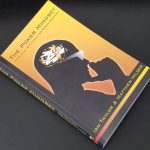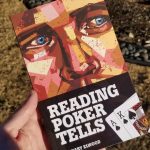When facing opponents at the poker table, we’re often placed in the position of trying to determine whether an opponent is bluffing or is holding a legitimate hand. If we can place them on a legitimate hand, then our decision comes down to simple math: are we getting the right odds to try to improve to a better hand? If our opponent might be bluffing, then the decision becomes more challenging. They could be semi-bluffing with a draw, or they could just have a weak holding that’s praying for a fold. But the question we’re going to take a closer look at today is: what if they’re bluffing with the best hand?
Let’s take a look at some recent poker hands I’ve encountered where players were bluffing with the best hand to see what lessons we can learn from each.
Hand #1: Pocket 66 Facing an All-In
This first hand takes place during the 2022 Wynn Summer Classic during a $580 entry $100,000 guaranteed no-limit Hold’em tournament.
We’re sitting on the button with pocket 6♠6♥. The blinds are 600/1,200 with a 1,200 ante from the big blind. The middle position player limps in, and I limp behind in position. The small blind completes, and the BB decides to raise his option, making it 6,200. The original limper folds, and after thinking on it, we both have deep enough chip stacks that I decide it’s worth a call given the implied odds if we hit a set vs. a big hand. The small blind folds, so we’re heads-up to the flop.
The flop is Q♣5♠7♠. Surprisingly, our opponent checks to us, which from past experience, typically means one of three things:
- He missed the flop (e.g.: AK),
- The flop has given him an incredibly strong hand (e.g.: QQ), or
- He has an underpair to the top pair on the board (e.g.: JJ).
Our pocket 66 still has showdown value against hands that missed the flop, and I don’t want to bloat the pot with such a weak holding, so I’m happy to check back.
The turn is 2♠. After about 30 seconds of thinking, our opponent makes a surprising move, which is to over-bet the pot, pushing all-in for 41,700. With the pot only being 16,000, this bet definitely has me raising my eyebrows. Jumping back to the 3 scenarios I mentioned, let’s see how this bet aligns with each of these hand ranges:
- A hand that missed the flop (e.g.: AK) could have picked up a spade draw on the turn. He may feel comfortable pushing his chips in as a semi-bluff, hoping for a fold, but knowing that he has some equity if called given that he has a spade draw. This is certainly a possibility.
- Top set of QQQ (or similar) would probably want to extract max value from a weaker holding. Making a smaller bet would do just that, and I would not expect such a hand to bet so much here. It’s probably safe to rule out such a holding here.
- An underpair to the board (e.g.: JJ) should still theoretically be scared if we’ve got a Q in our hand. This bet sizing might get top pair with a weak kicker to fold, which is probably the best Q we have here given that we didn’t raise pre-flop; he could be trying to get such hands to fold. The stronger argument for his bet, though, is if he’s trying to price out a flush draw. It’s possible that he’s making a bet with such a hand, though I don’t give this option as much weight as the first.
After considering the above hand ranges relative to his bet sizing, the first scenario feels like the most likely. If that’s the case, then our hand is ahead, and we have to not only dodge another spade, but also a card that pairs his hand. Since we’re holding a spade, that would mean there are 8 spades left in the deck that help him, and 6 cards that he could pair up against. In other words, 14 cards on the river help him, and 30 cards don’t help him. If that’s true, then we’re 2:1 to win this pot with a call.
Given my thought process, despite how daunting the bet size is relative to the pot, I put in the chips to call.
Our opponent shows pocket 8♣8♦, meaning that we’re actually facing scenario 3, which I had unfortunately ruled out. Our opponent was bluffing with the best hand, and we need to hit a 6 or a spade on the river, meaning we have 11 outs to improve.
The river is 9♥, and we lose a pretty significant pot at this point in the tournament.
Hand #2: Cold 4-Betting with A5
I recently took a shot at some $5/10 NLH, a pretty significant jump in stakes compared to the $1/2 and $1/3 I’m used to playing in Texas. (The Texas games play pretty big though, and I’d heard that $1/3 in Texas plays a lot like $5/10 in Vegas, and specifically at the Bellagio according to Brad Owen.) I found a home at Bellagio myself during a recent trip there, which is when this hand took place.
We’re dealt A♣5♣ in the cutoff. The first player to act raises to $40, and the next player immediately 3-bets to $120. It folds to us, and I decide to get a little aggressive, cold 4-betting with a hand I’d never considered making such a move with in the past. I hadn’t gotten out of line up to this point in the session, and I think it would exude strength to make such a raise. I make it $300 with an effective chip stack of $1,500.
It folds back to the the player who 3-bet. He makes the call, and we’re heads-up to the flop.
The flop is 4♣A♥Q♠. We flop top pair, but we don’t have a great kicker. However, we’ve shown strength, and when our opponent leads into us for $210, I don’t take long before deciding to stick with that aggression, pushing all-in for $1,200 total.
Our opponent goes into the tank for over two minutes before eventually settling on a call. When he calls, I’m immediately worried that he’s holding an ace with a bigger kicker — probably AK or perhaps AQ, though AQ seems to be unlikely given how long he took to call.
The turn is 3♥, and the river is 4♠. With the 4 pairing the board on the river, I’m desperately hoping for a chop against a better ace. I show our hand, and after a moment, he mucks his hand! The player on my right can’t believe it, as he reacts with a series of exasperated “whats?” I have a hard time believing it as well, and I immediately find myself trying to analyze what hands would call there that we beat.
After reflecting on it, I’m inclined to believe that he had exactly pocket KK. It’s about the only hand that I can make sense of given the action, while taking the liberty of assuming that he thought I was bluffing.
I’m new to these bigger games, but from the four sessions of $5/10 that I played in during this Vegas trip, I did see a lot more aggression with wider ranges than you would ever expect to see at your typical $1/2 or $1/3 game. Given that, it’s possible that he thought I could be making a raise as a bluff with a suited connector or a pair smaller than the cards on the flop (e.g.: JJ or TT). These hands would only be able to win by betting big and getting a fold. Our opponent attributed our big bet to a bluff, which was correct! Unfortunately for him, we happened to be bluffing with the best hand given that we were holding an ace that paired on the flop — albeit, an ace with a weak kicker.
Hand #3: Pocket 77 Facing a Check-Raise
This last hand takes place at a $1/3 NLH game at The Lodge in Round Rock, Texas.
We’re deal 7♠7♥ on the button. Action folds to the hijack, who raises to $15. We could 3-bet this hand sometimes given the late position raise, but I opt to call in this particular instance. The big blind calls as well, and the three of us take a flop.
The flop is 6♦2♥T♠, so we’ve got second pair to the board. If neither opponent paired up with the T on board, then our hand is probably good. The big blind checks to the pre-flop raiser who continuation bets for $20. We make a pretty standard call, and the big blind overcalls.
The turn is J♥. This isn’t a great card for our hand, but it could be a scare card since it’s higher than any of the cards already on board that both opponents had some amount of interest in. The action checks to us, and I take a stab at the pot, making it $50. The big blind hesitates briefly before making a 4x raise to $200. The third player folds, and now the action is back on us. Against most players, this is a pretty straightforward fold. However, having played against this opponent previously, I know that he’s a smart, thinking player, and he’s willing to get aggressive when he senses weakness.
Putting myself in his shoes, our play could certainly be viewed as weak here given our passive line on the flop, followed by our willingness to bet in position only after we’ve seen our opponents show weakness on the turn. After thinking on it, I recognize that this could very well be an attempt at a steal with a hand like second pair on the flop. Eventually, I make the call with the intention of calling most river bets — depending on the river card — given my thought process.
The river is 9♣. This is a pretty ugly card, considering that if our opponent was bluffing with a hand like 98 or 87 that had a gutshot on the flop, he’s now beating us. However, if he did have a hand like second pair, which is a hand I think this player could have in order to make this play, then there’s no reason to assume this river helped him.
He leads out for $475, and after some deliberation, I stick with my intention and put in the chips to call. Our opponent shows Q♠T♠ for top pair on the flop. I was correct that he was bluffing on the turn and river, as this is a scary board for such a holding; however, he was bluffing with the best hand here, holding top pair on the flop as opposed to second pair, which is what I anticipated.
Lessons Learned
In the first hand with pocket 66, we called an all-in where we turned out to be pretty far behind. We didn’t improve, and our chip stack took a significant hit.
I’m not much of a tournament poker player, typically playing cash games. I hadn’t put enough thought into the idea that, although we wouldn’t be crippled by losing this hand, we certainly would be in much worse shape. In cash games, we can just rebuy when we lose, but the same isn’t true of tournament poker. Every chip is valuable, and we should be willing to walk away from questionable spots like this one in favor of higher confidence spots where we have a greater probability of winning. Ultimately, when it comes to tournaments, it’s not about winning the battle so much as winning the war.
In the second hand with A5, we got our opponent to pay us off with a pair lower than our own by making a bet that didn’t correlate with a legitimately strong hand that’s hoping for a call. Although our intention in this hand was to get a fold from hands that beat us, we actually ended up getting a call from a hand that we’re beating instead.
I think there are two takeaways from the way this hand played out:
- First, if our opponents are higher level thinkers, then running a bluff like this won’t work out in our favor when they show up with a hand like AK, AQ, or even AJ that has us beat on the flop.
- Second, if we’re making large overbets as bluffs and getting called (even if we are bluffing with the best hand), then that implies we should sometimes be making large overbets with our strong and even nutted hands in these same games, expecting to get called sometimes. There’s an opportunity for large value to be gained in such situations since some players will convince themselves that such a large bet has to be an attempt to steal the pot.
In the last hand where we held pocket 77, my play and choices here are, for the most part, atrocious. In retrospect, think there are two much better options on the turn when facing a check-raise:
- Fold. The spot is very marginal, and we can protect our stack and find better opportunities to win money.
- Re-raise. When we just called on the turn, we gave up control of the hand. We allowed our opponent to make another bet on the river, which gives him another opportunity to win the pot on top of possibly having the best hand at showdown. By re-raising instead, we take back control of the action, and one of two things happen: either our opponent relents in the case that he’s bluffing; or he continues, at which point we can give up. This is certainly not a play without risk; we’re still contributing money to the pot in a questionable spot. However, we’re giving ourselves two ways to win instead of one: by garnering a fold, or by having the best hand at showdown.
In the end, folding is the correct action in nearly all cases here.
If you enjoyed this article, check out my poker vlog where you can watch me play live poker and hear my analysis as I break down my thought process.







